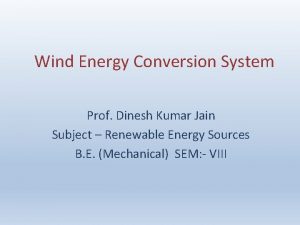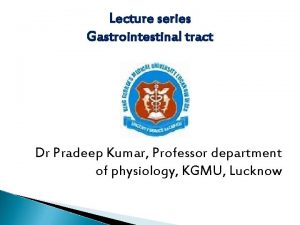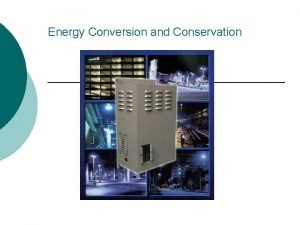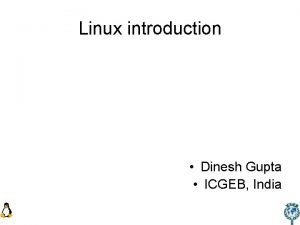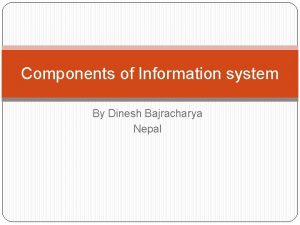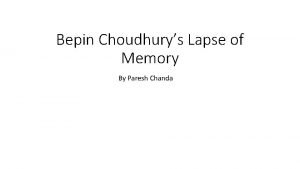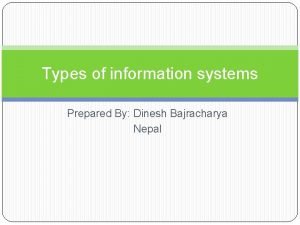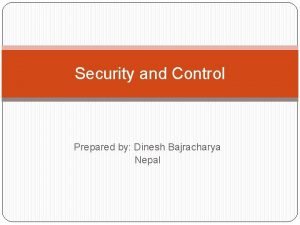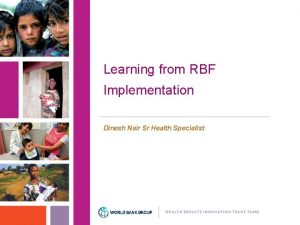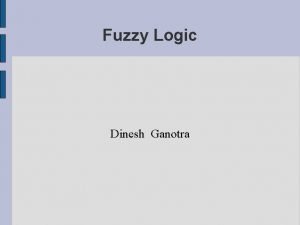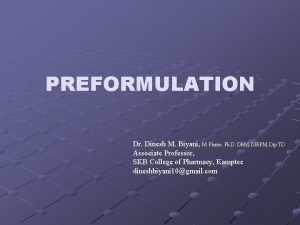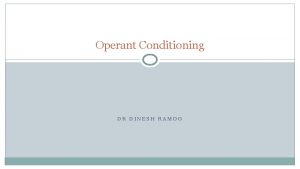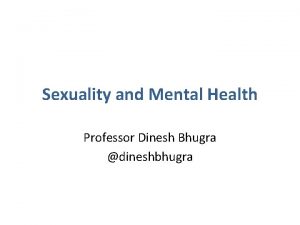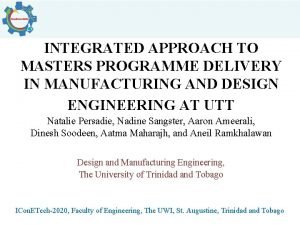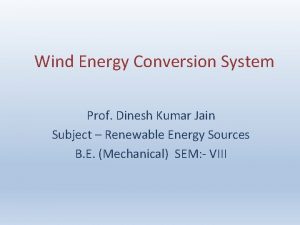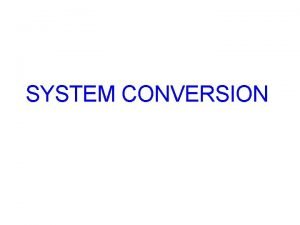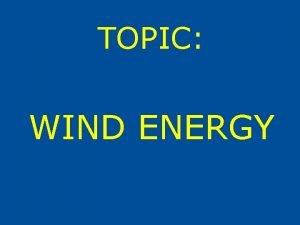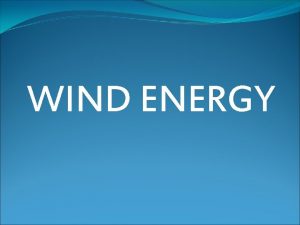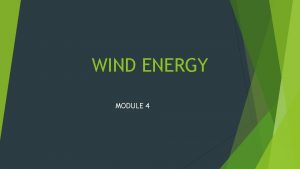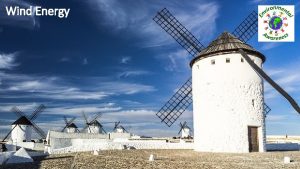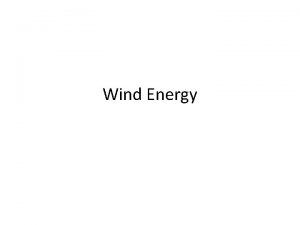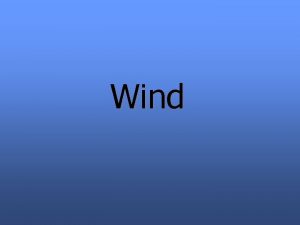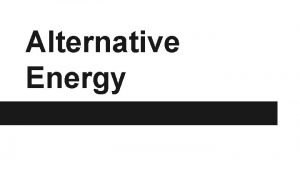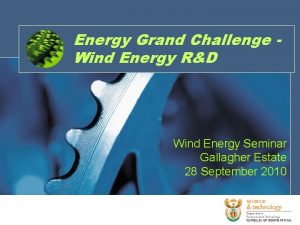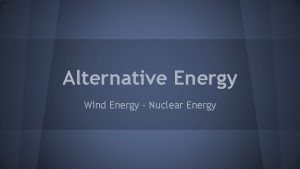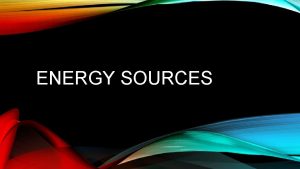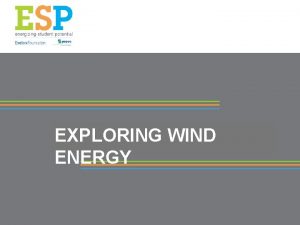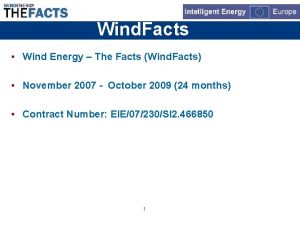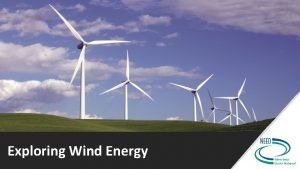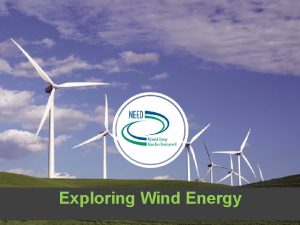Wind Energy Conversion System Prof Dinesh Kumar Jain


















- Slides: 18

Wind Energy Conversion System Prof. Dinesh Kumar Jain Subject – Renewable Energy Sources B. E. (Mechanical) SEM: - VIII

Wind Energy • Wind energy is the kinetic energy that is present in moving air. The amount of potential energy depends mainly on wind speed, but is also affected slightly by the density of the air, which is determined by the air temperature, barometric pressure and altitude. • • • The benefits of wind energy It is a pollution-free, infinitely sustainable form of energy. It doesn’t require fuel. It doesn’t create greenhouse gasses. It doesn’t produce toxic or radioactive waste. Prof. Dinesh Kumar Jain Renewable Energy Sources

Block diagram of basic wind energy conversion system Prof. Dinesh Kumar Jain Renewable Energy Sources

Wind electric Generating Station Prof. Dinesh Kumar Jain Renewable Energy Sources

Wind Energy Conversion System Prof. Dinesh Kumar Jain Renewable Energy Sources

Components of wind power plant • Rotor /Blade/Aero-turbine: Blade extracts significant power from the wind. They convert the force (K. E. ) of the wind into the rotary motion to generate useful mechanical power. • Hub: Hub of the wind turbine is that component which connects the blades to the main shaft and ultimately to the rest of drive train. Hubs are generally made up of steel. • Main Shaft (Low speed shaft): It is provided for transfer of torque from the rotor blade to the rest of the drive train. It also supports weight of rotor. Speed of the shaft is low, is about 30 to 60 rotations per minute. Prof. Dinesh Kumar Jain Renewable Energy Sources

Contd… • High speed shaft: It is connected to generator via-gearbox. Speed of the wind turbine is low; gearing arrangement increases the speed of rotation to the level as per design. e. g. 1500 rpm for 50 Hz frequency and 1800 rpm for 60 Hz frequency necessary to generate electricity with the help of generator. Gear box is one of the heaviest and most expensive component in wind turbine. • Coupling: Coupling are used to connect shaft together Between main shaft and gear box Between gear box output and the generator. • Brakes: The brakes are fitted to stop the wind turbine. By applying the brakes when dangerously strong wind are approaching i. e. when wind speed exceeds 55 -65 miles per hour, the wind turbine is stopped to avoid damage. In case of emergency also it is used to stop the rotation of turbine. To take down the turbine for maintenance, brakes are applied to stop it. Prof. Dinesh Kumar Jain Renewable Energy Sources

Contd… • Yaw Controller: It brings the blades towards the face into the wind direction i. e. it detects the direction of wind. It performs the task of orienting the rotor in the direction of wind. • Pitch Controller: The pitch controller adjust automatically the pitch of each blade i. e. blade can be rotate to increases efficiency in low wind and to decrease in very strong winds (to protect the wind turbine. • Electrical Generator: Function of generator is to convert mechanical energy produced by wind turbine into electrical energy. Prof. Dinesh Kumar Jain Renewable Energy Sources

Contd… • Anemometer: It is a wind direction sensor with digital display. Used in areas where AC power is not available. It monitors wind speed and stores max and average value. • Controller: Controller takes data from anemometer (which measures the wind velocity): The controller sense wind direction & wind speed The controller protect wind turbine from abnormal wind conditions, excessive temperature rise of generator, electrical fault etc. • Nacelle: Nacelle cover provides weather protection for the principle components of the wind turbine. It is structure that houses all of the generating components like-gearbox, rotor shaft and brake assembly etc. • Tower: A tower is needed to elevate the blades to where the wind is stronger and smoother. Towers are supports to raise the main part of the turbine up in the air. Prof. Dinesh Kumar Jain Renewable Energy Sources

Wind Turbines & Classification • wind turbine is a rotating machine which converts the kinetic energy in wind into mechanical energy. If the mechanical energy is then converted to electricity, the machine is called a wind generator, wind turbine, wind power unit (WPU), wind energy converter (WEC), or aerogenerator. • Wind turbines can be separated into two types based by the axis in which the turbine rotates. • Turbines that rotate around a horizontal axis are more common. Vertical-axis turbines are less frequently used. Prof. Dinesh Kumar Jain Renewable Energy Sources

HORIZONTAL AXIS WIND TURBINES • Horizontal-axis wind turbines (HAWT) have the main rotor shaft and electrical generator at the top of a tower, and must be pointed into the wind. Most have a gearbox, which turns the slow rotation of the blades into a quicker rotation that is more suitable to drive an electrical generator. • Since a tower produces turbulence behind it, the turbine is usually pointed upwind of the tower. Turbine blades are made stiff to prevent the blades from being pushed into the tower by highwinds. Additionally, the blades are placed a considerable distance in front of the tower and are sometimes tilted up a small amount. Prof. Dinesh Kumar Jain Renewable Energy Sources

HORIZONTAL AXIS WIND TURBINES Prof. Dinesh Kumar Jain Renewable Energy Sources

Horizontal axis Turbines Ref. 2 Prof. Dinesh Kumar Jain Renewable Energy Sources

Vertical axis Wind Turbines • Vertical-axis wind turbines (or VAWTs) have the main rotor shaft arranged vertically. Key advantages of this arrangement are that the turbine does not need to be pointed into the wind to be effective. This is an advantage on sites where the wind direction is highly variable. VAWTs can utilize winds from varying directions. • With a vertical axis, the generator and gearbox can be placed near the ground, so the tower doesn't need to support it, and it is more accessible for maintenance. Drawbacks are that some designs produce pulsating torque. Drag may be created when the blade rotates into the wind. Prof. Dinesh Kumar Jain Renewable Energy Sources

Vertical axis Wind Turbines (a) Savonious Rotor (b) Darrieus Rotor Prof. Dinesh Kumar Jain Renewable Energy Sources Ref. 3

Wind Turbines Prof. Dinesh Kumar Jain Renewable Energy Sources

Reference 1. Text book of Non Conventional Energy Sources by G. D. Rai 2. https: //fenix. tecnico. ulisboa. pt/download. File/84 4820067124338/dissertacao. pdf 3. Experimental and Numerical Analysis on Small Scale Wind Turbines: A Review International Journal of Applied Engineering Research ISSN 09734562 Volume 13, Number 8 (2018) pp. 97 -111 © Research India Publications. http: //www. ripublication. com Prof. Dinesh Kumar Jain Renewable Energy Sources

Thank you Prof. Dinesh Kumar Jain Renewable Energy Sources
 Vertical axis wind turbine ppt
Vertical axis wind turbine ppt Cholegogue
Cholegogue Wind energy is actually an indirect form of
Wind energy is actually an indirect form of Energy conversion of a toaster
Energy conversion of a toaster Hiren international recruitment process
Hiren international recruitment process Dr dinesh bhatt
Dr dinesh bhatt Dinesh gupta icgeb
Dinesh gupta icgeb Dinesh bajracharya
Dinesh bajracharya Who was paresh chanda?
Who was paresh chanda? Dinesh bajracharya
Dinesh bajracharya Dinesh bajracharya
Dinesh bajracharya Dr dinesh nair
Dr dinesh nair Dinesh ganotra website
Dinesh ganotra website Dinesh parekh portfolio
Dinesh parekh portfolio Dr dinesh parekh
Dr dinesh parekh Skinner experiment
Skinner experiment Dr dinesh bhugra
Dr dinesh bhugra Dinesh soodeen
Dinesh soodeen Physx
Physx
